
November 15, 2021 Ryukyu Shimpo
Motobu – A crowd of people gathered November 14 at Shinzato Fishing Port in Motobu, where a large amount of pumice stone has floated into the harbor, and got to work helping with the effort to remove it. The crowd was rallied by Okinawa resident Shinji Miayzato, 40, host of the YouTube channel “Okinawa Samurai,” after he put out the call for help on social networking sites. According to Miyazato, over 300 people answered the call to volunteer, with young adults and parents with children making up many of those who came.
There were large transport vehicles, kei trucks, and even excavators brought to the loading site and made available for volunteers to use. Volunteers scooped up the pumice with buckets and shovels, placed them into bags, then loaded them into the transport vehicles.
Motobu mayor Takeyasu Taira was thankful for, “so many people coming.” One 44-year-old dump truck driver who came from Yomitan to help said, “This is a problem that everyone in Okinawa has to work as one to solve.” Miyazato said, “I think that this is something we can accomplish if do it together.”
(English translation by T&CT and Sam Grieb)
Go to Japanese

November 19, 2021 Ryukyu Shimpo
On the evening of November 18 at the Futenma Air Station in Ginowan City, Okinawa, suspension training was conducted using an MV-22 Osprey vertical takeoff and landing transport aircraft from the air station. The training involved a rectangluar, cage-like object being suspended from and pulled back up to the aircraft while the aircraft hovered near the center of a runway of the air station. This training was repeated nine times. According to the Ginowan Municipal Government, the Osprey also conducted suspension training on the air station on November 9. Up to this point, accidents involving dropped objects have been occurring one after another, and it is extremely unusual for suspension training to be conducted at Futenma Air Station, which is surrounded by urban areas. This appears to run counter to base burden reduction efforts, and people living in the vicinity have made complaints and expressed indignation.
>> [Video] Osprey conducts suspension training at Futenma, unusually near to urban areas
The Ryukyu Shimpo has confirmed that suspension training was intermittently conducted using the Osprey between around 2:40 p.m. and 4:20 p.m. on November 18. At times, strong winds blew, and the suspended object swung dramatically left and right. The first suspension training lasted about 2-3 minutes, and during this time the aircraft hovered at a constant altitude.
According to the Ginowan City Base Relations Division, residents have lodged six complaints pertaining to noise as of 4:30 p.m. on November 18. During repeated suspension training involving the hovering of the Osprey, complaints such as “It has been loud for one or two hours straight” and about the issue of “low-altitude flying” were brought to the division.
In an interview with the Ryukyu Shimpo on November 18, a spokesperson for the Marine Corps in Okinawa insisted on the propriety of the training, stating that all of the training conducted at Futenma Air Station (on November 18) was essential for fulfilling the United States’ duties in its security guarentee to Japan based in Article 5 of the U.S.-Japan Security Treaty. This reasoning was not clear in that the specifics of the training cannot be described as having a security motive.
Before the training, the U.S. military issued a notice to airmen about the suspension training. Although the Okinawa Defense Bureau (ODB) received inquiries about implementation of the training, the ODB did not respond until nighttime on November 18. As of the evening of November 18, the Okinawa Prefectural Government was still collecting information pertaining to these matters.
(English translation by T&CT and Erin Jones)
Go to Japanese

November 18, 2021 Ryukyu Shimpo
Chatan – On November 17, a general meeting of an association that supports individuals and family members of individuals who have been exposed to asbestos as a result of the U.S. military presence in Okinawa was held at the Chatan Chamber of Commerce Hall. The group works to get relief for former employees, or families of employees of U.S. military bases who were victims of asbestos exposure during their work. Naoyuki Toyama is a lawyer who has been in charge of the asbestos-related lawsuits in Okinawa. He gave a lecture at the meeting, discussing the need for lawsuits to get relief for victims. “For decades, these individuals devoted themselves to doing their jobs. It’s only natural that they have a right to ask for compensation if the country employing them was negligent.”
Toyama has been in charge of ten completed asbestos-related lawsuits in Okinawa and has not lost any of these cases. All have ended in a settlement with the government.
At the general meeting, it was decided that Masako Zamami would assume the role of chair beginning November 17. Zamami says, “I hope to continue finding the victims of asbestos exposure and to help them to get relief.” Inquiries and consultations can be directed to the Okinawa Center for Former Military Base Employees (Okinawa Churyugun Rishokusha Center), phone number: 098 (923) 0151.
(English translation by T&CT and Ellen Huntley)
Go to Japanese

November 15, 2021 Ryukyu Shimpo
The Japan Ground Self-Defense Force (JGSDF) transported surface-to-air and surface-to-ship missiles November 14 from the Miyakojima Garrison over the water to the Bora Training Grounds. Under occasional heavy rain, Miyakojima residents rushed to Hirara Port and to the entrance of the Bora training grounds in protest, calling for their removal and chanting, “Missiles are an obstacle to peace!”
The munitions were carried the training grounds in a truck. The JGSDF truck, which had a red “fire” symbol to indicate that it was carrying explosives, drove through bustling crowds in commercial districts, cutting its way through the city surrounded by an ostentatious guard.
The Japan Maritime Self-Defense Force’s (JMSDF) Shimokita transport craft, which was loaded with the missiles, docked at Hirara Port at 7:00 a.m. After docking, around 15 cargo trucks that appeared to have containers filled with munitions disembarked onto the wharf.
In front of the wharf gate, citizens who oppose the JSDF missile deployment conducted a “die-in,” lying flat on the ground as if they were corpses in a harsh protest of the transport. Police officers began removing protestors for a “traffic violation,” and around 11:00 a.m. the trucks were able to depart. At the entrance of the Bora Training Grounds protesters also conducted a sit-in, protesting the delivery of the missiles to the training area. After protestors were again removed by the police, the trucks entered the base and finished their delivery just after 1:00 p.m.
During World War 2, the Japanese army had a cart filled with munitions in the Bora region explode, killing a young child. One of the protestors of at the sit in, a farmer, 80, from Gusukube, Miyako, criticized, “Many of the elderly know what happened at that time, and oppose the deployment. It is a problem that this transfer happened without a meeting to explain things.” Hiromori Shimoji, co-representative of the “Citizens Group to Oppose Missile and Munition Deployment” said, “Starting today we are living under a cloud of anxiety.” He criticized the southwestern shift of defensive fortifications, saying, “Why does Okinawa need to be put in harm’s way as the site of a proxy war between America and China?”
(English translation by T&CT and Sam Grieb)
Go to Japanese

November 11, 2021 Ryukyu Shimpo
On November 10, the winner of the 2021 Japan Booksellers’ Award for Nonfiction, which is organized jointly by Yahoo News and Hontai, was announced. Bookstore clerks throughout Japan vote on the winner, and this year, chose University of the Ryukyus Professor Yoko Uema’s Umi wo Ageru (published by Chikuma Shobo).
Uema spoke at the award ceremony held in Tokyo. “I believe that this award is not for me, but for Okinawa, and that it is an expression of well-wishes to children who experience hardship living in Okinawa,” she said.
Umi wo Ageru is Uema’s first collection of personal essays and in them, she has written about life with her family and young daughter, and feelings she has experienced over the course of her continuing work researching and supporting teen mothers. The essays also address problems that permeate daily life in Okinawa such as the issue of the military bases, and the mistreatment of the islands by the government and authorities.
In her speech, Uema spoke of the day that, newly a teenager, she was told by her mother to hold her keys in her hand when she went out. She continued, “After coming to Tokyo, I learned that I didn’t need to walk with my keys in my hands, even at night. But now, I’m raising a daughter, and so this has become a very real concern for me again.” Uema also talked about her essay “Ariel no Okoku” (Ariel’s Kingdom), in which she writes about the day that soil was poured into the sea at Henoko for construction of the new U.S. military base.
“You could say that Umi wo Ageru was written because of ‘Ariel no Okoku.’ When I compiled the book, I thought only of one thing: how could I make people in Tokyo and the rest of Japan understand the pain of living in this Okinawa with my little girl?” she said. “I wanted to write about how, no matter how much we try, the government’s actions always show us that it doesn’t matter. When I wrote ‘Ariel no Okoku,’ I put in a lot of work so that when you read it, you will feel that the problem is your own. And a lot of people in different places brought their expertise to, and put a lot of work into this book as well. I think they were hoping to bring the book this kind of attention.”
Okinawa continues to experience problems caused by the presence of the military bases. Uema ended her 15-minute speech saying, “Our islands are so small that they can be hard to find on a map, but problems that Japan wants to be both out of sight and out of mind are pushed onto us. Umi wo Ageru is Pandora’s Box in which I’ve written about our country’s Achilles heel. And today, that book is in the spotlight. Pandora’s box has been opened, and the only thing left is one hope: that we don’t give up on justice, fairness, and the future that we want for our children.”
(English translation by T&CT and Ellen Huntley)
Go to Japanese
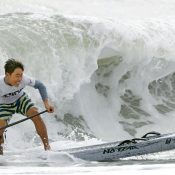
November 12, 2021 Ryukyu Shimpo
By Hideki Matsudo
Nago – The Carolina Cup, part of the Association of Paddlesurf Professionals (APP) 2021 world tour, took place November 6 and 7 in North Carolina. At the competition, 15-year-old Shuri Araki, a ninth-grader at Ryokufu Gakuen in Nago, ended the competition ranked third overall, the youngest ever to do so. The event features races and technical competitions in standup paddleboarding (SUP). Only the top 35 athletes in the sport gain entry to the world tour, and Araki is the youngest ever to secure a spot.
Stormy weather had put the event at risk at one point, but changes were made to the courses to allow the event to take place. Araki placed 4th in the 15 km long-distance race that took place on the first day, and 6th in the 500-meter surf sprint event, where surfers compete for speed
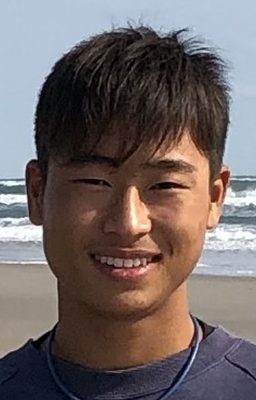
Shuri Araki
riding waves, for an overall finish in 3rd place.
SUP is a competition where surfers stand on their boards, and Shuri has already won the world championship in the junior division and finished 3rd in the men’s open division. His father Takuji, 47, said looking ahead to the future, “Shuri will be 22 when the Los Angeles Summer Olympics comes (in 2028). If [SUP] is added as an official event of the games, I think he can certainly secure the gold medal.”
Since Araki was a preschooler, Araki would follow his fisherman grandfather Akinobu Tamaki, 81, into the ocean near his home in Abu, Nago, enjoying ocean activities such as net fishing. After graduating elementary school, he started learning SUP from his father Takuji, who also competed in the SUP World Cup, and very quickly gaining ability.
Shuri said enthusiastically, “The waves in Okinawa and here in North Carolina are quite different so this was a challenge, but my ability to conquer the stormy seas in this competition is a result of training in the Yanbaru wilderness. I can’t wait to get back to Okinawa and tell everyone.”
(English translation by T&CT and Sam Grieb)
Go to Japanese
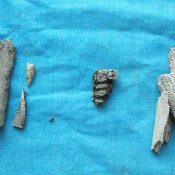
November 12, 2021 Ryukyu Shimpo
The Max Planck Institute for the Science of Human History in Germany led 42 researchers from various countries such as South Korea, China, the United States, Japan including Okinawa, concluding before November 11 that the DNA (genome) of the prehistoric human bones unearthed around the Nagabaka burial site in Shimajiri Hirara, Miyakojima City, and those of the Jomon-era Japanese, were a 100% match. In the past, the prehistoric people of Miyako Island were believed to have come from the south, such as the Philippines and Taiwan. The result of this genome analysis establishes the possibility they may have come from the north, such as Okinawa Island. The study’s progression will be followed closely.
The paper titled “Triangulation supports the agricultural spread of the Transeurasian languages” was published in the British science journal Nature, and illustrates the migration routes of the Japanese, Ryukyuan, Korean, Mongolian languages.
Excavations at the Nagabaka burial site began in 2005, where prehistoric human bones and ornamental artifacts have been found. The genome of the unearthed human bones was analyzed and summarized in this paper.
The paper assumes that the farming techniques and language used by the prehistoric farmers who cultivated proso millet and foxtail millet in China’s West Liaohe region during the Neolithic period arrived in Okinawa through Korea and Kyushu. Co-author of the paper and Naha City-native, Professor Hiroto Takamiya, (Research Center for the Pacific Islands at Kagoshima University) said, “We illuminated the origins of the vernacular and people of the Ryukyus Islands and identified the agricultural transition period. It will be necessary to accumulate more data from the human bones, such as what grains were domesticated.”
Co-author Mitsugu Kugai of the Miyakojima City Board of Education said, “DNA analysis had never been conducted on the bones of prehistoric Miyako people before. Comparing that with the bones excavated from Japanese archaeological sites provides a novel and important perspective.”
(English translation by T&CT and Monica Shingaki)
Go to Japanese

November 11, 2021 Ryukyu Shimpo
On November 9, the Kin Town Council (chaired by Yoshimitsu Kakazu) opened an extraordinary session and unanimously passed a written opinion requesting an investigation into the cause and countermeasures pertaining to the problem of the levels of organic fluorine compounds (PFAS) detected in tap water, groundwater sources, and rivers in Kin Town, Okinawa, exceeding the national provisional guideline value.
The council unanimously passed a revised budget of 3,707,980 yen for the municipal waterworks account, including a water pipe construction design sum of 1,652,000 yen for switching tap water to water from the Prefectural Enterprise Bureau. The aim is for construction to start in 2022, and for the total amount to be switched sometime in 2023.
The written opinion touches on the fact that all of the PFAS detection sites are near Camp Hansen, and indicates that it is essential to enter the military base grounds to investigate. It is alluded to, in the written opinion, that it is essential to carry out swift facility development to switch the total amount of tap water over to be supplied by the Prefectural Enterprise Bureau. The written opinion also contains four requests: (1) an investigation into the cause by the central government, and countermeasures based thereon, (2) cooperation with the investigation entering military bases in Okinawa, (3) essential steps toward the reliable supply of tap water, and (4) drastic revision of the US-Japan Status of Forces Agreement.
This written opinion is being sent to seven people including the prime minister, the minister of defense, the director of the Okinawa Defense Bureau, and the Ministry of Foreign Affairs’ ambassador in charge of Okinawan affairs.
The revised budget includes, aside from the water pipe construction design costs, 594,000 yen for water quality tests to examine the levels of PFAS in the tap water, and 1,461,980 yen for the purchasing costs of an increased supply of water from the Prefectural Enterprise Bureau along with restricting water intake from groundwater sources.
(English translation by T&CT and Erin Jones)
Go to Japanese
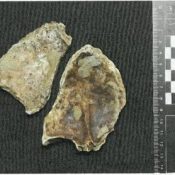
November 8, 2021 Ryukyu Shimpo
The Uruma Board of Education (BoE) announced November 8 that human remains dating back as far as 9,000-10,000 years was discovered at the Yabuchi Caves archeological site in Uruma. The remains appear to be skull fragments, are would be the oldest human remains of the Kaizuka people ever discovered. This is the first human remains discovered dating to the period between the Paleolithic era 14,000 years ago and the Kaizuka era 7,000 years ago. The discovery is thought to be a valuable “missing link” between the two.
In the Okinawan archipelago, the time period after the Paleolithic up until around the 11th-century B.C.E. known as the Jomon era in mainland Japan is called the “Kaizuka era.” In Okinawa, the Minatogawa people from around 22,000 years ago represent the oldest Paleolithic human remains ever found in Japan. However, before now the oldest remains from the Kaizuka era were around 7,000 years old, discovered in the Ufudobaru ruins Nago.
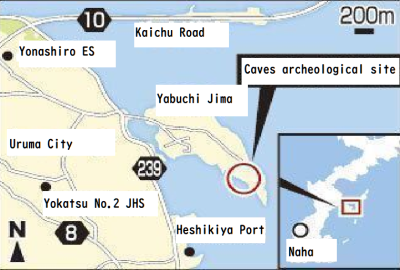 The Uruma BoE conducted an archeological survey at the Yabuchi Caves from 2014-2016. In 2016, 9,000-year-old pottery fragments
The Uruma BoE conducted an archeological survey at the Yabuchi Caves from 2014-2016. In 2016, 9,000-year-old pottery fragments
were discovered, the oldest ever found in Okinawa. These human remains were also excavated during this dig, and w
ere confirmed to be from the Kaizuka era based on the geological stratum and morphological features of the bone fragments.
The two skull fragments were excavated from around 60-70 cm below the surface, with both fragments being around 10 cm in size. One of the bones is from the frontal bone of the skull, located between the eyebrows, and the gentle arch leads researchers to hypothesize that it belongs to a female. Additionally, there is a coronal suture, tissue that connects the frontal and parietal bones, present, suggesting that the age of the person was in their prime adult years, older than a teenager but under 40. Comparing it to other Kaizuka-era remains, it also appears to have the characteristic rectangular eye socket.
Since the bone fragments are in good condition, the city has indicated that it may be possible to uncover additional human remains from the surrounding area. They will also continue to study any possible connections between Paleolithic and Kaizuka peoples.
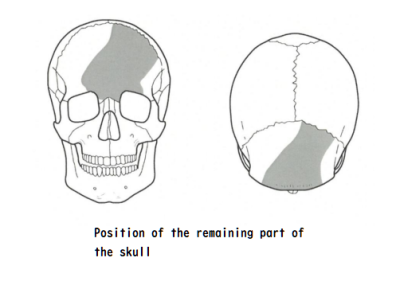 The remains, as well as some of the earthenware uncovered in the Yabuchi Caves, will be on display at the Amawari History and Culture Museum in Katsuren, Uruma from November 9-21 and December 14-January 30. From November 23-December 5 they will be exhibited at the Okinawa Prefectural Museum.
The remains, as well as some of the earthenware uncovered in the Yabuchi Caves, will be on display at the Amawari History and Culture Museum in Katsuren, Uruma from November 9-21 and December 14-January 30. From November 23-December 5 they will be exhibited at the Okinawa Prefectural Museum.
(English translation by T&CT and Sam Grieb)
Go to Japanese
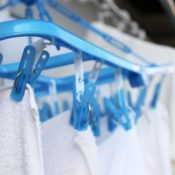
November 5, 2021 Ryukyu Shimpo
By Mariko Nakamura
On November 4, the Personal Support Center for work and livelihood support in Naha announced that they had received approximately 8000 consultations over the course of the 2020 fiscal year, 8 times the number received in 2019. Thus far, 2021 is outpacing 2020, with 5000 consultations received between April and October. The Personal Support Center supports needy individuals living in Naha. Incomes in the area have declined due to the coronavirus pandemic, leading to increasing numbers of struggling households. Tetsuzou Nagayoshi, who is in charge of the Personal Support Center, is concerned. “We have more and more cases where people who have been scraping by are struggling to even put food on the table because of the lack of jobs from the pandemic.”
Throughout late October, the Personal Support Center, located in the Good Job Center Okinawa in Izumizaki, Naha, had an endless stream of clients coming in for advice. The center is open for consultations from 9 a.m. to 4 p.m. with a lunch break at midday. However, the sheer number of clients meant that they were unable to even close for lunch.
The Personal Support Center offers advice to individuals struggling with day-to-day life or finding work, and helps them get government support. They have approximately 40 consultations per day, either in person or by phone. According to Nagayoshi, many consultations come from small business owners or non-regular employees who have less income due to Covid 19. Most are in the restaurant or tourism industries. There are also consultations from foreign residents who have lost their part-time jobs.
In past years, the center would have around 1000 consultations per year, with many being from middle-aged or elderly clients. However, since the pandemic began, the number of 20- and 30-year-olds has grown. Clients struggling to find work include single-mother and single-father households, but also elderly households where grandparents are taking care of children who have lost parents.
Last year, the consultations overwhelmingly related to being unable to pay rent. The center accepts applications for the Housing Security Benefit, which is supplied by the Ministry of Health, Labour, and Welfare, with a maximum amount determined by the local government. In past years, there have been approximately 20 applications per year. In 2020, approximately 1400 applications were submitted.
(English translation by T&CT and Ellen Huntley)
Go to Japanese

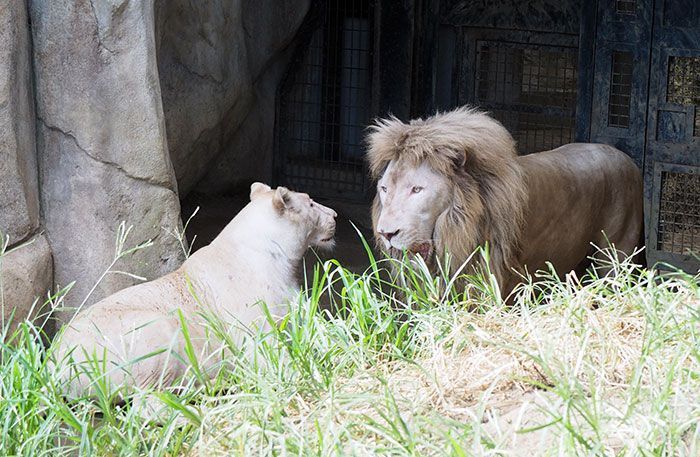









 The Uruma BoE conducted an archeological survey at the Yabuchi Caves from 2014-2016. In 2016, 9,000-year-old pottery fragments
The Uruma BoE conducted an archeological survey at the Yabuchi Caves from 2014-2016. In 2016, 9,000-year-old pottery fragments The remains, as well as some of the earthenware uncovered in the Yabuchi Caves, will be on display at the Amawari History and Culture Museum in Katsuren, Uruma from November 9-21 and December 14-January 30. From November 23-December 5 they will be exhibited at the Okinawa Prefectural Museum.
The remains, as well as some of the earthenware uncovered in the Yabuchi Caves, will be on display at the Amawari History and Culture Museum in Katsuren, Uruma from November 9-21 and December 14-January 30. From November 23-December 5 they will be exhibited at the Okinawa Prefectural Museum.
 Webcam(Kokusai Street)
Webcam(Kokusai Street)


